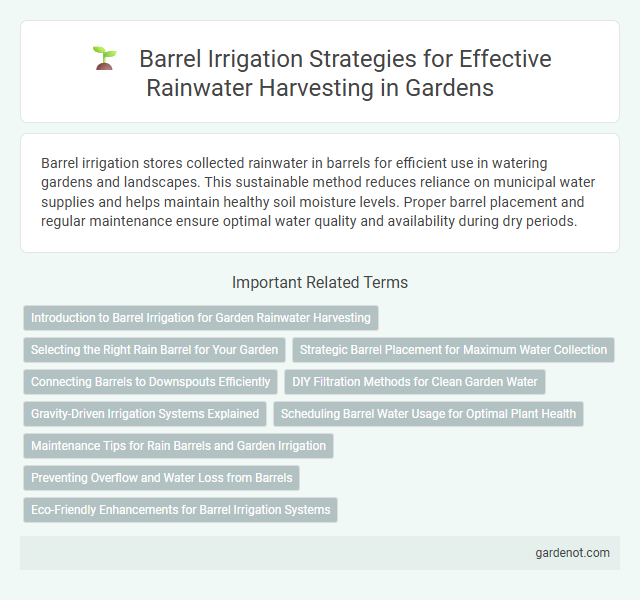Barrel irrigation stores collected rainwater in barrels for efficient use in watering gardens and landscapes. This sustainable method reduces reliance on municipal water supplies and helps maintain healthy soil moisture levels. Proper barrel placement and regular maintenance ensure optimal water quality and availability during dry periods.
Introduction to Barrel Irrigation for Garden Rainwater Harvesting
Barrel irrigation utilizes collected rainwater stored in barrels to efficiently hydrate garden plants, reducing dependence on municipal water supplies. This method involves directing runoff from rooftops into barrels via gutters, creating a sustainable water source for slow, targeted irrigation. By harnessing rainwater, barrel irrigation supports water conservation and promotes healthier plant growth in home gardens.
Selecting the Right Rain Barrel for Your Garden
Choosing the right rain barrel for your garden involves considering capacity, material, and built-in features like filtration and spigot placement. Opt for food-grade, UV-resistant barrels with a capacity suited to your garden size--typically 50 to 100 gallons for residential use ensures efficient water storage without overflow. Prioritize models with easy-to-clean openings, secure lids to prevent debris and mosquitoes, and compatible attachments for hose or drip irrigation systems to maximize rainwater harvesting benefits.
Strategic Barrel Placement for Maximum Water Collection
Strategic barrel placement for maximum water collection involves positioning rain barrels near downspouts and at the lowest points of a roof's drainage system to capture the highest volume of runoff. Placing barrels in shaded areas minimizes evaporation, ensuring better water preservation for irrigation use. Proper alignment with gutters and secure foundations prevents overflow and maximizes rainwater harvesting efficiency.
Connecting Barrels to Downspouts Efficiently
Connecting barrels to downspouts efficiently involves using diverter kits that redirect water directly into rain barrels while preventing overflow and reducing debris entry. Installing a screen or filter at the barrel inlet enhances water quality by blocking leaves and contaminants. Properly sealed connections and positioning the barrel on a raised platform improve water flow and ease of access for irrigation use.
DIY Filtration Methods for Clean Garden Water
Barrel irrigation enhances rainwater harvesting by storing clean, filtered water for garden use through efficient DIY filtration methods. Common techniques include using coarse mesh screens to block debris, layered sand and charcoal filters to remove sediments and impurities, and simple biofilters with activated carbon for improved water quality. These cost-effective filtration solutions ensure healthy plants and sustainable water management in home gardening systems.
Gravity-Driven Irrigation Systems Explained
Barrel irrigation utilizes gravity-driven irrigation systems to efficiently distribute collected rainwater without the need for pumps or external power sources. Water stored in elevated barrels flows naturally through pipes or hoses to plants, ensuring a steady and controlled supply that conserves resources and reduces maintenance. This method is especially effective for small-scale gardens and promotes sustainable water management by maximizing rainwater use.
Scheduling Barrel Water Usage for Optimal Plant Health
Scheduling barrel water usage in rainwater harvesting systems is crucial for maintaining optimal soil moisture and promoting healthy plant growth. Efficient irrigation timing, based on plant water requirements and weather conditions, prevents overwatering and conserves harvested rainwater. Implementing automated or manual schedules tailored to crop type enhances water use efficiency and supports sustainable garden management.
Maintenance Tips for Rain Barrels and Garden Irrigation
Regularly inspect rain barrels for cracks and leaks to ensure efficient water storage and prevent contamination. Clean gutters and screens monthly to avoid debris buildup that can clog irrigation systems and reduce water flow. Winterize barrels by draining and storing them indoors to prevent damage from freezing temperatures and maintain optimal garden irrigation.
Preventing Overflow and Water Loss from Barrels
Barrel irrigation systems significantly reduce water loss by incorporating overflow prevention mechanisms such as overflow valves and raised outlet pipes. These features ensure excess rainwater is safely redirected away from the barrel, preventing spillage and soil erosion. Properly sealed lids and gutter guards also minimize evaporation and contamination, optimizing water retention for efficient irrigation.
Eco-Friendly Enhancements for Barrel Irrigation Systems
Barrel irrigation systems benefit from eco-friendly enhancements such as integrating biodegradable filters to reduce plastic waste and employing solar-powered pumps to minimize carbon emissions. Using rainwater harvesting barrels made from recycled materials supports sustainable water conservation while promoting environmental responsibility. Incorporating natural soil moisture sensors optimizes water usage, ensuring efficient irrigation and reducing runoff.
Barrel irrigation Infographic

 gardenot.com
gardenot.com